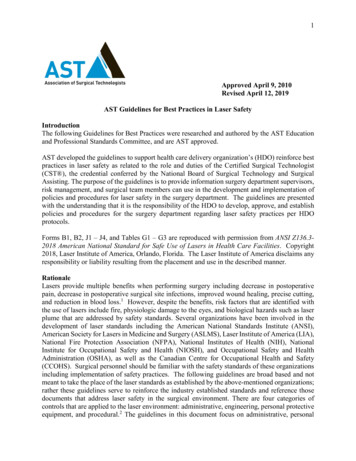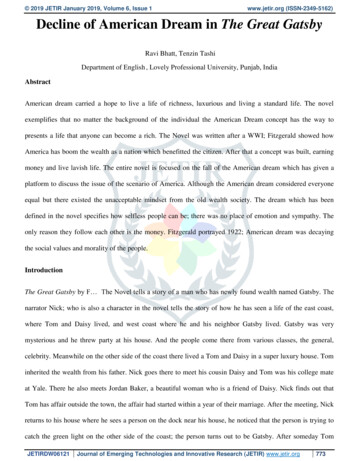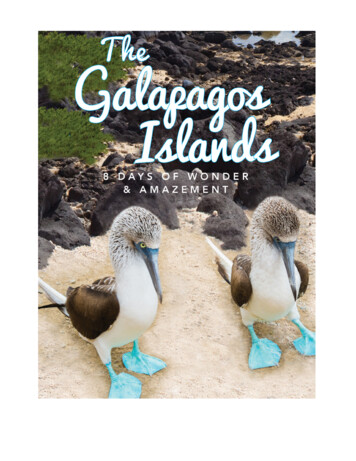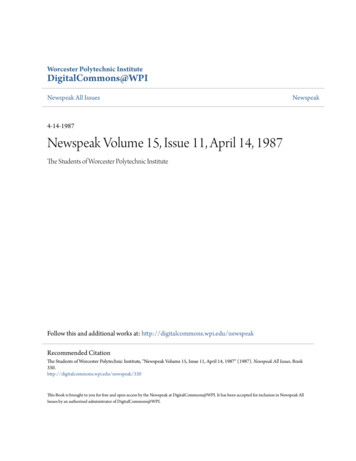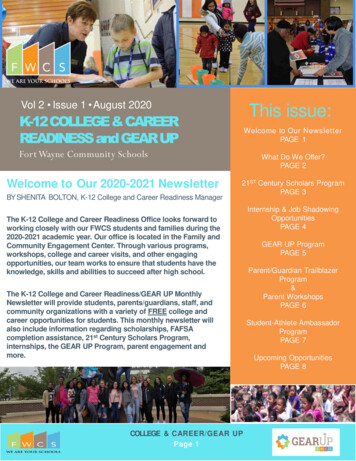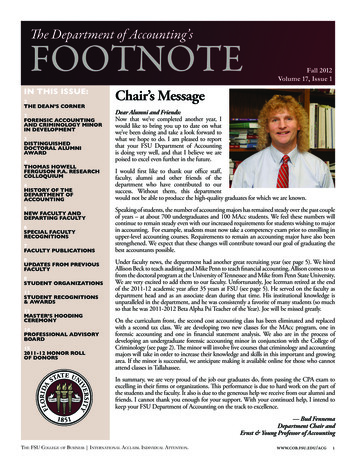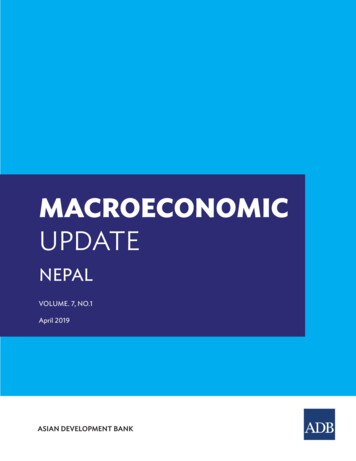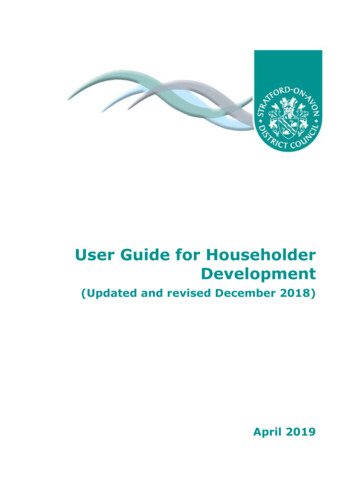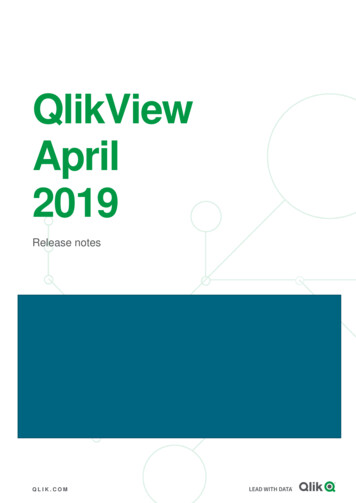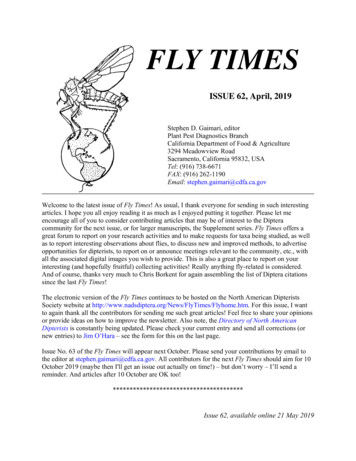
Transcription
FLY TIMESISSUE 62, April, 2019Stephen D. Gaimari, editorPlant Pest Diagnostics BranchCalifornia Department of Food & Agriculture3294 Meadowview RoadSacramento, California 95832, USATel: (916) 738-6671FAX: (916) 262-1190Email: stephen.gaimari@cdfa.ca.govWelcome to the latest issue of Fly Times! As usual, I thank everyone for sending in such interestingarticles. I hope you all enjoy reading it as much as I enjoyed putting it together. Please let meencourage all of you to consider contributing articles that may be of interest to the Dipteracommunity for the next issue, or for larger manuscripts, the Supplement series. Fly Times offers agreat forum to report on your research activities and to make requests for taxa being studied, as wellas to report interesting observations about flies, to discuss new and improved methods, to advertiseopportunities for dipterists, to report on or announce meetings relevant to the community, etc., withall the associated digital images you wish to provide. This is also a great place to report on yourinteresting (and hopefully fruitful) collecting activities! Really anything fly-related is considered.And of course, thanks very much to Chris Borkent for again assembling the list of Diptera citationssince the last Fly Times!The electronic version of the Fly Times continues to be hosted on the North American DipteristsSociety website at tm. For this issue, I wantto again thank all the contributors for sending me such great articles! Feel free to share your opinionsor provide ideas on how to improve the newsletter. Also note, the Directory of North AmericanDipterists is constantly being updated. Please check your current entry and send all corrections (ornew entries) to Jim O’Hara – see the form for this on the last page.Issue No. 63 of the Fly Times will appear next October. Please send your contributions by email tothe editor at stephen.gaimari@cdfa.ca.gov. All contributors for the next Fly Times should aim for 10October 2019 (maybe then I'll get an issue out actually on time!) – but don’t worry – I’ll send areminder. And articles after 10 October are OK too!***************************************Issue 62, available online 21 May 2019
CONTENTSNEWSKirk-Spriggs, A.H. — Second “J.O. Westwood Medal” . 1Keatley Garvey, K. — Jessica Gillung Wins International Early Career Awardin Entomology for her work on Acroceridae . 2–4Plant, A.R. — Inventory of Aquatic Hemerodromiinae and Clinocerinae(Diptera: Empididae) inhabiting Tufa Stream Environments of TropicalKarst Ecosystems in Thailand . 5–7Ruiz, C., & Pimienta, M.C. — Behavior of adult Leucopis sp. (Chamaemyiidae)associated with aphids feeding on flowers of the rough-leaf velvetseed(Guettarda scabra: Rubiaceae) in south Florida . 8–10Gaimari, S.D. — Ashley Kirk-Spriggs relocated to the Natural History Museum,London . 11Dankowicz, E., & Cohen, C. — Diptera and iNaturalist: A case study fromAsiloidea . 12–17Kotrba, M. — Wanted: Fresh material of Cryptochetum iceryae (Cryptochetidae). 18–19Cabrero, A. — Specimen Request: Bee flies in the genus Lordotus Loew, 1863 . 20Gray, R. — Continuing Investigations on the Mycetophilidae of Northern Nevada. 21–23Hribar, L.J. — Polymera crane flies in the Florida Keys (Limoniidae) – a crane flycranium cracker . 24–26Brodo, F. — A Snow Crane Fly Making Good Use of His Halteres . 27–28Lambkin, C. — Queensland Museum at the World Science Festival Brisbane . 29–30Merritt, R. — New (5th) edition of Merritt, Cummins & Berg (An Introductionto the Aquatic Insects of North America) available soon . 31Balcombe, J. — Author of forthcoming book on flies seeks your input . 32Wallace, J.R., Hutchinson, P., & Thomas, K. — Preliminary evaluation of aportable ‘in-home’ use ovitrap (STUCK ) for adult mosquito surveillanceand control . 33–40Craig, D. — Early high-speed Super 8mm film of larva Simuliidae filter feeding . 41Evenhuis, N.L., & Gaimari, S.D. — “How Time Flies, Celebrating the 80thbirthday of Dr. John C. Deeming” . 42MEETING NEWSCourtney, G., & Bowles, D. — North American Dipterists Society, 2019 FieldMeeting, 3-7 June 2019, Bull Shoals Field Station, Missouri, Final Announcement. 43–45Dikow, T., & Bertone, M. — Annual NADS meeting in St. Louis, Missouri. 46Cranston, P.S. — The IX International Congress of Dipterology, Namibia. 47–50Kung, G.-A. — Fly School, 23 June–6 July 2019 . 51OPPORTUNITIESMarshall, S.A. (submitted by) — Open position at the University of Guelph . 52Diko, T., & S.W. Willston Fund committee — S.W. Williston Diptera ResearchFund at the National Museum of Natural History, Smithsonian Institution . 53DIPTERA ARE AMAZING! . 54–57BOOKS AND PUBLICATIONS . 58–76SUBMISSION FORM, DIRECTORY OF NORTH AMERICAN DIPTERISTS . 77***************************************
Fly Times, 62NEWSSecond “J.O. Westwood Medal”Ashley H. Kirk-SpriggsDepartment of Life Sciences, Natural History MuseumCromwell Road, London SW7 5BD. United Kingdom;a.kirk-spriggs@nhm.ac.ukDr Art Borkent (right) was the secondrecipient of the prestigious “J.O. WestwoodMedal”, awarded by the Royal EntomologicalSociety of London. Medals are awarded for“The best comprehensive taxonomic work ona group of insects, or related arthropods.Typically, this will be a taxonomic revisionor monograph.” Art was given the award inrecognition of his paper:Borkent, A. 2008. The frog biting midgesof the World (Corethrellidae: Diptera).Zootaxa 1804: 1–456.Unfortunately, at that time (2010), he wasunable to attend the presentation of the Medaland this was officially awarded to Art by DrAshley Kirk-Spriggs (left), in the CentralHall of the Natural History Museum, London,during Art’s recent visit to the Museum. Art(in collaboration with Patrycja Dominiak), iscurrently preparing the Ceratopogonidaevolume of the Royal Entomological Society’sHandbooks for the Identification of BritishInsects series.***************************************1
2Fly Times, 62Jessica Gillung Wins International Early Career Awardin Entomology for her work on AcroceridaeKathy Keatley GarveyDepartment of Entomology and Nematology, University of California,Davis, California, USA; kegarvey@ucdavis.eduPostdoctoral fellow Jessica Gillung of Cornell University, who received her doctorate in entomologyfrom UC Davis, is the recipient of the prestigious Marsh Award for Early Career Entomologist,sponsored by the Royal Entomological Society.She is the first UC Davis-affiliated scientist to win the award. She will receive a certificate, 1250pounds ( 1,624) and an expense paid trip to London to receive the award at the Ento 19 conference,set Aug. 20-22 at the London School of Hygiene and Tropical Medicine.The Royal Entomological Society, an international organization devoted to the study of insects, wasfounded in 1833 as the Entomological Society of London. Its mission is to disseminate informationabout insects and improve communication between entomologists.Gillung’s work on spider flies, involving genomics, phylogenetics, systematics, and comparativeanalyses, “has increased our understanding of the biological patterns and processes that have shapedour planet’s biodiversity,” wrote her major professor and award nominator Lynn Kimsey, director ofthe Bohart Museum of Entomology and a professor of entomology, UC Davis Department ofEntomology and Nematology.Gillung received her doctorate in entomology from UC Davis in December 2018, studying withKimsey and mentor Shaun Winterton, insect biosystematist, California Department of Food andAgriculture, and a member of the Royal Entomological Society. Gillung also collaborated with antspecialist and taxonomist Phil Ward, professor, UC Davis Department of Entomology andNematology.Gillung is now a postdoctoral associate at Cornell University in the Bryan Danforth lab, where she isresearching Apoidea (stinging wasps and bees) phylogenomics, evolution and diversification.Her dissertation, “Systematics and Phylogenomics of Spider Flies (Diptera, Acroceridae),” focusedon the evolution, conservation, biology, and taxonomy of spider flies, a group of spider naturalenemiesGillung’s taxonomic work on spider flies, described as landmark, included identification keys andmorphology-based diagnoses of species using modern techniques of cybertaxonomy—the applicationof the internet, digital technologies, and computer resources to increase and speed up the discoveryand cataloging of new species, Kimsey wrote. “Using cybertaxonomic tools, Jessica described 25new spider fly species herself, and in collaboration with fellow entomologists, three fossil speciesfrom Baltic amber, described in her first dissertation chapter. Cybertaxonomy is a powerful tool thatallows researchers and citizen scientists to collaborate in real time and across great distances toincrease the speed and efficiency of biodiversity discovery.”
Fly Times, 623Jessica Gillung, with Jade Winterton at the Grand Canyon, Arizona, in June 2014.“Jessica unraveled the functional and ecological implications of key morphological traits, as well astheir distribution across the Tree of Life,” Kimsey said. “In her doctoral dissertation, she establishednew homologies for the wing venation of spider flies and conducted detailed and assiduousdissections of male reproductive structures (i.e., genitalia) to understand homologies, demonstratingthat morphological traits are dynamically evolving systems useful for both classification andinference of evolutionary history.”Since many insect species are threatened, geographically restricted, or relatively rare in nature,Gillung performed non-destructive DNA extraction of specimens housed in entomologicalcollections, including the Bohart Museum of Entomology. Gillung collected molecular data fromdecades-old insects without damaging the specimens.Gillung’s multifaceted research on genomics, bioinformatics, phylogenetics, plant-pollinatorinteractions, and biodiversity discovery drew more 120,000 in grants and awards while at UCDavis.The UC Davis alumnus is known for her “phenomenal leadership activities, her nearly straight-Aacademic record (3.91 grade point average), her excellence as an entomologist and teacher, herpublic service and outreach programs (from 2013 to 2018, she reached more than 20,000 people atUC Davis-based events) and her incredible publication record, Kimsey said. “She published 11
4Fly Times, 62refereed publications related to her thesis in very strong journals. Most entomologists do not publishnearly that much, even as a postdoctoral scholar or a junior faculty member.”A recipient of numerous other awards, Gillung won the prestigious international award for “BestStudent Presentation Award” at the ninth annual International Congress of Dipterology, held in 2018in Windhoek, Namibia. She also won the 2019 Early Career Award from the Pacific Branch,Entomological Society of America (PBESA) and the 2018 PBESA Student Leadership Award.PBESA encompasses 11 western states, U.S. territories and parts of Canada and Mexico.Gillung was a key member of the 2015 PBESA championship Linnaean Team that went on to winthe ESA national championship. The Linnaean Games are lively question-and-answer, college bowlstyle competition on entomological facts played between university-sponsored student teams.Gillung also collaborated on a project aimed at encouraging students to attend and participate in theOrlando, Fla., meeting of the International Congress of Entomology. She and several colleaguespublished a paper entitled “From the Students to the Students: Why YOU need to Attend ICE 2016.”The Royal Entomological Society will publish her biography and photo in its Antenna magazine, onthe society website, and in the Marsh Christian Trust Award brochure.***************************************
Fly Times, 625Inventory of Aquatic Hemerodromiinae and Clinocerinae (Diptera: Empididae) inhabitingTufa Stream Environments of Tropical Karst Ecosystems in ThailandAdrian R. PlantDivision of Research Facilitation and Dissemination, Mahasarakham UniversityMahasarakham, Thailand; eanddrs@gmail.comWork is now underway to learn more about the Diptera of calcareous waters in karst landscapes inThailand. The entomology of tropical karstic systems has been greatly neglected even ‘though intemperate latitudes karsts are well known as important biodiversity hotspots. In many parts of theworld, including Thailand, these “imperiled arcs of biodiversity” are under threat from activities suchas cement extraction, removal of vegetation cover by fire and damage to their hydrological systemswith agricultural runoff etc.Although karst biota includes numerous eurytopic generalists, many of the plants and animalsoccurring there are highly specialised stenotopes; terrestrial forms must adapt to extreme ariditywhile aquatic organisms must be able to tolerate extreme mineralisation, high pH and in some casesseasonal drying of streams and springs or cataclysmic spates. Although karst landscapes are widelydistributed globally, they are widely dispersed, and this fragmentation has inevitably led to restrictedgene-flow, intense population divergence and high local and regional endemism.Karst landscapes account for about 18% of the land area of Thailand and they are widely distributedthrough the country excepting the Isaan Plateau in the northeast. The limestones of Thai karsts are ofvariable geological age, forming isolated pockets in some places and extensive mountain ranges inothers. Many tourists will be familiar with the spectacular karst islands (including “James BondIsland”) of Pang Nga bay in the south of the country of the massive limestone block of DoiChiangdao (Thailand’s second highest mountain) in the north.Whilst the botany and herp-fauna of Thai karsts have been reasonably well studied, for example, Ican find no substantive work on any aspect of their entomology. It was thus exciting for me when myproposal to start correcting this situation gained financial support of the Thailand Research Fund andapproval from Mahsarakham University. The basic objectives of the Project are: To compile an inventory of aquatic Empididae associated with calcareous waters in Thailand.Identify or describe the species present.Characterise the communities they form and correlate them with environmental variablesGeographic and eco-historical isolation of Thailand’s karst systems has likely led to highlevels of endemism and genetic isolation of populations. Evidence of low gene-flow betweendisjunct populations will be sought and related to historical patterns of habitat fragmentationusing haplotype mapping of CO1.Look for evidence of homeostatic refugia. Pleistocene cooling events formerly drove manyanimals and plants southwards. It is possible that some of them got trapped there in relativelycool spring systems as the climate warmed again. The prime candidate for this is theEmpididae subfamily Clinocerinae of which Thailand communities are probably ofPalaearctic origin and have become restricted now to the cool climates of the highestmountains.
6Fly Times, 62Figure 1. A. Hemerodromia anomala Plant is probably strictly associated with tufa formations in fast streams inseveral different provinces of Thailand. B. Hemerodromia conspecta Plant is another species probably strictlyassociated with tufa streams. Adults of it and H. anomala can be found on the undersides of leavesoverhanging the water or very close to the streamside, always in dense shade. C. The Sai You Yai waterfall inKanchanaburi Province is a wide tufa fan that spills into the Kwai Noi River. D. Suan Hom waterfall in LoeiProvince is a large and very actively growing tufa system where the tufa rapidly engulfs trees and otherobjects present in the flow. This site has a rich fauna of tufa-specialist Empididae. E. The waterfall at ErawanNational Park is a major tourist attraction. It is a fine example of a tufa barrier and pool system.
Fly Times, 627At the time of writing, seven months into the 2-year project, it has been possible to visit and samplemany of Thailand’s major karst areas. Although it is possible to easily locate karst areas from largescale geological maps, selecting precise collecting sites such as sinks, springs, Vauclusian seeps,resurgences and tufa-terraces is far more difficult (though good quality topographic maps exist andmark many such features, they are effectively unavailable, especially to a foreigner working in areasnear national borders). Local knowledge can sometimes help in locating new collecting sites, but it isoften deeply flawed and unreliable. Finding suitable localities requires boots on the ground andplenty of time to explore. On the other hand, some of the best waterfall and tufa sites are managed astourist attractions and although easy to locate and visit, they are often in protected areas and severelydamaged by tourist activity making them less attractive sampling prospects.The project seems well set to achieve its objectives. In particular, several obligate tufa species that Ihad previously described from an isolated karstic complex in Loei Province have now been found atother, remote tufa sites in other provinces. These disjunct populations of species such as H. anomalaPlant, H. conspecta Plant will be ideal subjects to investigate genetic isolation. Other species (such asH. namtokhinpoon Plant or H. anisoserrata Plant) have yet to be found away from their typelocalities and it is possible that they will turn out to be very narrow range endemics. The finding ofundescribed Hemerodromiinae species (and indeed species already known elsewhere) was inevitableand unsurprising, especially considering the intense focus on a narrow range of habitats (a specialistgetting ‘low down and dirty’ to investigate different micro-habitats will find many taxa that aremissed by more generalist collecting campaigns with Malaise traps and sweep nets etc).In conclusion; the project has got off to a promising start and we can anticipate interesting results.Meanwhile there are more sites to visit (and site visits at different seasons too), species to describe,ecological data to crunch and genes to isolate and sequence. Hopefully, at some later date there willbe a fascinating story to tell.***************************************
Fly Times, 628Behavior of adult Leucopis sp. (Chamaemyiidae) associated with aphids feedin
Kimsey and mentor Shaun Winterton, insect biosystematist, California Department of Food and . even as a postdoctoral scholar or a junior faculty member.” . the ESA national championship. The Linnaean Games are lively question-and-answer, college bowl-
